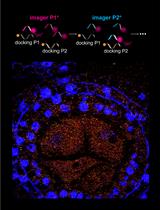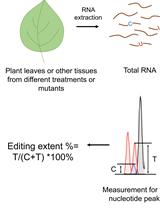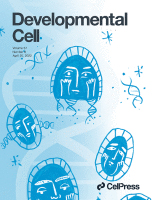- Submit a Protocol
- Receive Our Alerts
- Log in
- /
- Sign up
- My Bio Page
- Edit My Profile
- Change Password
- Log Out
- EN
- EN - English
- CN - 中文
- Protocols
- Articles and Issues
- For Authors
- About
- Become a Reviewer
- EN - English
- CN - 中文
- Home
- Protocols
- Articles and Issues
- For Authors
- About
- Become a Reviewer
Profiling of Single-cell-type-specific MicroRNAs in Arabidopsis Roots by Immunoprecipitation of Root Cell-layer-specific GFP-AGO1
Published: Vol 12, Iss 24, Dec 20, 2022 DOI: 10.21769/BioProtoc.4575 Views: 2177
Reviewed by: Anonymous reviewer(s)

Protocol Collections
Comprehensive collections of detailed, peer-reviewed protocols focusing on specific topics
Related protocols

Micrografting in Arabidopsis Using a Silicone Chip
Hiroki Tsutsui [...] Michitaka Notaguchi
Jun 20, 2021 7788 Views

A Novel Method to Map Small RNAs with High Resolution
Kun Huang [...] Jeffrey L. Caplan
Aug 20, 2021 4598 Views

Quantitative Analysis of RNA Editing at Specific Sites in Plant Mitochondria or Chloroplasts Using DNA Sequencing
Yang Yang and Weixing Shan
Sep 20, 2021 3223 Views
Abstract
MicroRNAs (miRNA) are small (21–24 nt) non-coding RNAs involved in many biological processes in both plants and animals. The biogenesis of plant miRNAs starts with the transcription ofMIRNA (MIR) genes by RNA polymerase II; then, the primary miRNA transcripts are cleaved by Dicer-like proteins into mature miRNAs, which are then loaded into Argonaute (AGO) proteins to form the effector complex, the miRNA-induced silencing complex (miRISC). In Arabidopsis, some MIR genes are expressed in a tissue-specific manner; however, the spatial patterns of MIR gene expression may not be the same as the spatial distribution of miRISCs due to the non-cell autonomous nature of some miRNAs, making it challenging to characterize the spatial profiles of miRNAs. A previous study utilized protoplasting of green fluorescent protein (GFP) marker transgenic lines followed by fluorescence-activated cell sorting (FACS) to isolate cell-type-specific small RNAs. However, the invasiveness of this approach during the protoplasting and cell sorting may stimulate the expression of stress-related miRNAs. To non-invasively profile cell-type-specific miRNAs, we generated transgenic lines in which root cell layer-specific promoters drive the expression of AGO1 and performed immunoprecipitation to non-invasively isolate cell-layer-specific miRISCs. In this protocol, we provide a detailed description of immunoprecipitation of root cell layer-specific GFP-AGO1 using EN7::GFP-AGO1 and ACL5::GFP-AGO1 transgenic plants, followed by small RNA sequencing to profile single-cell-type-specific miRNAs. This protocol is also suitable to profile cell-type-specific miRISCs in other tissues or organs in plants, such as flowers or leaves.
Graphical abstract

Background
MicroRNAs (MiRNAs) play an important role in many cellular growth and development processes. A fantastic feature of miRNAs is the non-cell autonomous action, in which miRNA moves from cell to cell or over long distances (Melnyk et al., 2011), serving as a signal molecule that functions locally or systemically. Previous studies have shown that the long distance or systemic movement of miRNA is mainly through the phloem, while cell-to-cell movement is through plasmodesmata (Melnyk et al., 2011). Mobile miRNAs, such as miR394 and miR165/6, have been shown to serve as morphogens, which shape the cell pattern formation during development (Breakfield et al., 2012; Carlsbecker et al., 2010; Knauer et al., 2013). Root cell layer-specific promoter-driven expression of AGO1, the core protein in the miRNA-induced silencing complex (miRISC), shows that AGO1 is cell autonomous (Brosnan et al., 2019; Fan et al., 2022). Microtubules have been shown to specifically regulate the association of miRNA165/6 with AGO1 in the cytoplasm and play a vital role in miRNA cell-to-cell movement (Fan et al., 2022). Therefore, characterization of miRNA distribution at a high spatial resolution is critical for understanding their functions in gene regulation. Here, we describe a protocol to profile cell-type-specific miRNA by immunoprecipitation of root cell layer-specific green fluorescent protein (GFP)-AGO1, followed by small RNAseq, that provides a new tool to deepen our understanding of the regulation of miRNA functions.
Materials and Reagents
RNase-free pipette tips [Genesee Scientific, catalog numbers: 23-130R (10 µL), 23-150R (200 µL), 23-165R (1,250 µL)]
1.5 mL centrifuge tubes (Genesee Scientific, catalog number: 22-282)
50 mL centrifuge tubes (Genesee Scientific, catalog number: 21-108)
15 mL centrifuge tubes (Genesee Scientific, catalog number: 21-103)
Petri dishes (Genesee Scientific, catalog number: 32-106)
Nylon mesh (mesh opening sizes 100 µm) (NITEX, catalog number: NTX100-098)
Liquid nitrogen
Phusion high-fidelity DNA polymerase (Thermo Fisher Scientific, catalog number: F-530XL)
In-Fusion HD cloning plus (Takara, catalog number: 638911)
Murashige and Skoog medium (MS) (PhytoTech Lab, catalog number: M524)
IGEPAL CA-630 (MilliporeSigma, catalog number: I8896)
GFP-Trap magnetic agarose (ChromoTek, gtd-20)
Sodium dodecyl sulfate (SDS) (MilliporeSigma, catalog number: L3771-500G)
β-mercaptoethanol (MilliporeSigma, M3148-250ML)
Glycerol (Thermo Fisher Scientific, catalog number: J16374.K2)
Glycogen RNA grade (Thermo Fisher Scientific, catalog number: R0551)
NEBNext multiplex small RNA library prep set for Illumina (New England Biolabs, catalog number: E7300)
10 bp O'RangeRuler DNA ladder (Thermo Fisher Scientific, catalog number: SM1313)
Sodium chloride (NaCl) (Thermo Fisher Scientific, catalog number: AAJ2161836)
DEPC-treated water (Thermo Fisher Scientific, catalog number: 4387937)
Trizma base (MilliporeSigma, catalog number: T1503)
TRI reagent (MRC, catalog number: TR118)
Clorox germicidal bleach (Thermo Fisher Scientific, catalog number: Essendant CLO30966EA)
Triton X-100 solution (MilliporeSigma, catalog number: 93443)
Bromophenol blue (MilliporeSigma, catalog number: B0126)
cOmplete, EDTA-free protease inhibitor cocktail (MilliporeSigma, catalog number: 11836170001)
GFP antibody (MilliporeSigma, catalog number: 11814460001)
Chloroform (Thermo Fisher Scientific, catalog number: 423550040)
Isopropanol (Thermo Fisher Scientific, catalog number: 423835000)
6× DNA loading dye (Thermo Fisher Scientific, catalog number: R0611)
Ethidium bromide (Thermo Fisher Scientific, catalog number: J67270.14)
Sodium acetate (Thermo Fisher Scientific, catalog number: A13184.30)
Seed sterilization solution (see Recipes)
2× protein SDS loading buffer (see Recipes)
IP lysis buffer (see Recipes)
Washing buffer (see Recipes)
5× TBE buffer (see Recipes)
12% polyacrylamide gel (see Recipes)
8% SDS-PAGE resolving gel (see Recipes)
SDS-PAGE stacking gel (see Recipes)
3 M sodium acetate (pH 5.2) (see Recipes)
Equipment
Plant growth chamber (Percival, model: CU36L5)
Microcentrifuge (Eppendorf, model: 5424R)
High-speed centrifuge (Beckman Counter, model: Avanti J-E Series)
DynaMag-2 magnet (Invitrogen, catalog number: 12321D)
H5600 revolver tube mixer (VWR, catalog number: H5600-15)
Thermocyclers (Bio-Rad, catalog number: 1851148)
Blade
Thermomixer C (Eppendorf, catalog number: 5382000015)
Spatula
Mortar and pestle
Mini-PROTEAN tetra vertical electrophoresis cell (Bio-Rad, catalog number: 1658001FC)
Procedure
Plasmid construction and plant transformation
Select root cell type-specific promoters [Endodermis 7 (EN7) for endodermis and Acaulis5 (ACL5) for metaxylem/procambium were used in this study] and amplify them from Arabidopsis genomic DNA.
Amplify the GFP-coding sequence from pMDC107 plasmid and the AGO1 genomic sequence containing the coding region and 3’ UTR from Arabidopsis genomic DNA using PCR (Phusion high-fidelity DNA polymerase). Assemble them with a root cell layer-specific promoter into pCambia1300 using In-Fusion HD cloning plus, according to the manual of the kit. A linker sequence of five amino acids (GGGGA) was inserted between GFP and AGO1 . The recombinant constructs were transformed into E. coli DH5α competent cell for verification (Renzette, 2011).
The constructs were transformed into Agrobacterium tumefaciens GV3101 by electroporation. Transgenic lines were generated by A. tumefaciens -mediated floral dip transformation (Clough and Bent, 1998).
Homozygous single insert transformants were selected by growing the transgenic lines on ½ MS (Half strength Murashige and Skoog Medium) containing antibiotics and used for the subsequent experiment.
Plant material preparation and collection
Measure 200 µL of transgenic seeds and sterilize with seed sterilization solution for 10 min by gently rotating at 18 rpm on a H5600 revolver tube mixer.
Briefly spin at 2,000 × g for 20 s to pellet the seeds and discard the bleach solution.
Resuspend the seeds with sterile water and gently rotate at 18 rpm for 1 min on a H5600 revolver tube mixer to wash the seeds. Repeat five times.
Cut the nylon mesh into 9 × 9 cm squares to fit inside 150 mm Petri dishes. Autoclave them for 20 min.
Transfer the nylon mesh onto the top of ½ MS Petri dishes in the sterile hood.
Sow 500 seeds per Petri dish in a line on top of the nylon mesh. Grow the plants vertically at 16 h light and 8 h dark and 22 °C for nine days.
Note: 200 μL transgenic seeds can be sowed into 10 plates and produce 2–3 g root tissues.
Harvest the roots by cutting them off with a blade at approximately 2 cm above the root tip.
Note: Change the blade regularly to avoid damaging the roots when slicing.
GFP-AGO1 immunoprecipitation
Grind 2 g of root tissue into fine powder in liquid nitrogen and add 4 mL of freshly prepared IP lysis buffer.
Incubate at 4 °C with gentle rotation at 18 rpm for 30 min.
Centrifuge at 16,000 × g for 20 min at 4 °C to remove the insoluble debris and repeat this step one more time.
Transfer 100 µL of supernatant to a new tube. Add 100 µL of 2× protein SDS loading buffer and heat at 95 °C for 5 min. Store the sample at -20 °C for western blotting.
Prewash 50 µL of GFP-Trap magnetic agarose beads with 1 mL of IP lysis buffer. Separate the beads with a magnetic stand and discard the supernatant. Repeat this step two more times.
Transfer the remaining supernatant from step C3 into a new tube and add the prewashed GFP-trap magnetic agarose beads.
Incubate on a rotator at 4 °C for 2 h.
Remove the supernatant by placing the tube on a magnetic stand. Wash the beads with 1 mL of washing buffer by rotating the tube at 4 °C for 5 min. Use the magnetic stand to separate the beads from the supernatant and discard the supernatant. Repeat this step four more times.
Resuspend the beads in 200 µL of washing buffer and transfer 20 µL (10% of the sample) into a new tube for western blot analysis. The remainder of the sample should be kept for RNA extraction and is referred to as the RNA sample.
Use a magnetic stand to separate the beads from the supernatant in the western blot sample and discard the supernatant. Resuspend the beads with 20 µL of 1× SDS loading buffer and heat the sample at 95 °C for 5 min. Separate the beads from the supernatant using the magnetic stand and transfer the supernatant to a new tube for western blot analysis.
Separate the beads from the supernatant in the RNA sample using the magnetic stand and discard the supernatant.
Add 500 µL of TRI reagent to the beads to resuspend the beads.
Add 100 µL of chloroform to the tube, shake vigorously, and allow sample to stand at room temperature for 5 min.
Centrifuge the mixture at 10,000 rpm and 4 °C for 15 min.
Transfer aqueous phase to a new tube and add 20 µg of glycogen.
Add an equal volume of isopropanol into the aqueous liquid, invert several times to mix and incubate at -20 °C for 60 min.
Centrifuge for 15 min at 10,000 rpm and 4 °C.
Discard the supernatant and wash the RNA pellets with 70% ethanol.
Remove the supernatant and air-dry the pellet at room temperature.
Dissolve the RNA in 7 µL of nuclease-free water. The RNA can be stored at -80 °C for small RNA library construction.
Western blot analysis for immunoprecipitation quality control
Load 20 µL per sample of the crude extract from step C4 and the GFP-AGO1 immunoprecipitate from step C9 on an 8% SDS-PAGE gel.
Follow the protocols for SDS-PAGE electrophoresis and western blotting to detect GFP-AGO1 using GFP antibody (Mahmood and Yang, 2012). The size of GFP-AGO1 is approximately 157 kDa.
Genome wide detection of root cell layer-specific AGO1-bound small RNAs
Recovered RNAs were subjected to library construction using NEBNext Small RNA Library Prep Set for Illumina according to the manual (https://www.neb.com/protocols/2018/03/27/protocol-for-use-with-nebnext-small-rna-library-prep-set-for-illumina-e7300-e7580-e7560-e7330).
sRNA library recovery for sequencing
Make a 12% polyacrylamide gel.
Add 6× DNA loading dye into the library, mix well by pipetting, and load the sample into the gel. Load 10 µL of 10 bp O'RangeRuler DNA ladder into the same gel.
Perform gel electrophoresis in 0.5× TBE buffer at 150 V for 90 min.
Stain the gel with ethidium bromide in 0.5× TBE buffer for 5 min. Cut out the bands at 140–150 bp.
Place the gel slice into a 1.5 mL centrifuge tube and smash the gel into small pieces using pipette tips.
Add 500 µL of 0.4 M NaCl into the tube and elute the sRNA library DNA from the gel by rotating the sample for 6 h or overnight at 4 °C.
Centrifuge the tube at 15,000 × g and room temperature for 1 min and transfer the supernatant into a new tube. Repeat this step two times; avoid transferring any gel into the tube.
Add 1/10 volume of 3 M sodium acetate, two volumes of 100% ethanol, and 20 µg of glycogen, mix the solution, and keep at -20 °C for 6 h.
Centrifuge at 16,000 × g for 30 min at 4 °C to pellet the library. Discard the supernatant and wash the pellet with 70% ethanol.
Centrifuge at 16,000 × g for 10 min at 4 °C, discard the supernatant, and air-dry the pellet.
Dissolve the library DNA in 30 µl of nuclease-free water.
Process the small RNAseq data using home-made pipeline pRNASeqTools (https://github.com/grubbybio/pRNASeqTools).
Data analysis
Small RNAseq data were analyzed by pRNASeqTools pipeline. Briefly, the adaptor sequence was trimmed by cutadapt 3.0. The trimmed reads were mapped to the genome Araport 11 using Shortstack. Mapped reads were normalized by calculating RPM (reads per million mapped reads) value.
Recipes
Seed sterilization solution
50% Clorox germicidal bleach
0.05% Triton X-100
2× protein SDS loading buffer
100 mM Tris-Cl (pH 6.8)
4% (w/v) SDS (sodium dodecyl sulfate; electrophoresis grade)
0.2% (w/v) bromophenol blue
20% (v/v) glycerol
200 mM β-mercaptoethanol
IP lysis buffer
50 mM Tris (pH 7.5)
150 mM NaCl
4 mM MgCl2
2 mM DTT
10% glycerol
0.1% IGEPAL CA-630
1× EDTA-free protease inhibitor cocktail
Store at 4 °C.
Washing buffer
50 mM Tris (pH 7.5)
150 mM NaCl
4 mM MgCl2
2 mM DTT
10% glycerol
0.5% IGEPAL CA-630
1× EDTA-free protease inhibitor cocktail
5× TBE buffer
450 mM Tris base
450 mM boric acid
10 mM EDTA
pH 8.3
12% polyacrylamide gel
8.85 mL of ddH2O
1.5 mL of 5× TBE buffer
4.5 mL of 40% acrylamide/Bis solution (29:1)
105 µL 10% APS
5.25 µL of TEMED
8% SDS-PAGE resolving gel
2.65 mL of ddH2O
1 mL of 40% acrylamide/Bis solution (29:1)
1.3 mL of 1.5 M Tris (pH 8.8)
50 µL of 10% SDS
50 µL of 10% APS
2 µL of TEMED
SDS-PAGE stacking gel
1.51 mL of ddH2O
0.20 mL of 40% acrylamide/Bis solution (29:1)
0.25 mL of 1.5 M Tris (pH 8.8)
20 µL of 10% SDS
20 µL of 10% APS
2 µL of TEMED
3 M sodium acetate (pH 5.2)
3 M sodium acetate
Adjust pH to 5.2 using glacier acid
Acknowledgments
This protocol was adapted from our previous work (Fan et al., 2022). This work was supported by a grant from National Institutes of Health (GM129373) to Xuemei Chen.
Competing interests
The authors declare no conflicts of interests.
References
- Breakfield, N. W., Corcoran, D. L., Petricka, J. J., Shen, J., Sae-Seaw, J., Rubio-Somoza, I., Weigel, D., Ohler, U. and Benfey, P. N. (2012). High-resolution experimental and computational profiling of tissue-specific known and novel miRNAs in Arabidopsis. Genome Res 22(1): 163-176.
- Brosnan, C. A., Sarazin, A., Lim, P., Bologna, N. G., Hirsch-Hoffmann, M. and Voinnet, O. (2019). Genome-scale, single-cell-type resolution of microRNA activities within a whole plant organ. EMBO J 38(13): e100754.
- Carlsbecker, A., Lee, J. Y., Roberts, C. J., Dettmer, J., Lehesranta, S., Zhou, J., Lindgren, O., Moreno-Risueno, M. A., Vaten, A., Thitamadee, S., et al. (2010). Cell signalling by microRNA165/6 directs gene dose-dependent root cell fate. Nature 465(7296): 316-321.
- Clough, S. J. and Bent, A. F. (1998). Floral dip: a simplified method for Agrobacterium-mediated transformation of Arabidopsis thaliana. Plant J 16(6): 735-743.
- Fan, L., Zhang, C., Gao, B., Zhang, Y., Stewart, E., Jez, J., Nakajima, K. and Chen, X. (2022). Microtubules promote the non-cell autonomous action of microRNAs by inhibiting their cytoplasmic loading onto ARGONAUTE1 in Arabidopsis. Dev Cell 57(8): 995-1008 e5.
- Knauer, S., Holt, A. L., Rubio-Somoza, I., Tucker, E. J., Hinze, A., Pisch, M., Javelle, M., Timmermans, M. C., Tucker, M. R. and Laux, T. (2013). A protodermal miR394 signal defines a region of stem cell competence in the Arabidopsis shoot meristem. Dev Cell 24(2): 125-132.
- Mahmood, T. and Yang, P. C. (2012). Western blot: technique, theory, and trouble shooting. N Am J Med Sci 4(9): 429-434.
- Melnyk, C. W., Molnar, A. and Baulcombe, D. C. (2011). Intercellular and systemic movement of RNA silencing signals. EMBO J 30(17): 3553-3563.
- Renzette, N. (2011). Generation of transformation competent E. coli. Curr Protoc Microbiol 22(1): A.3L.1-A.3L.5.
Article Information
Copyright
© 2022 The Authors; exclusive licensee Bio-protocol LLC.
How to cite
Fan, L., Gao, B. and Chen, X. (2022). Profiling of Single-cell-type-specific MicroRNAs in Arabidopsis Roots by Immunoprecipitation of Root Cell-layer-specific GFP-AGO1. Bio-protocol 12(24): e4575. DOI: 10.21769/BioProtoc.4575.
Category
Plant Science > Plant molecular biology > RNA > RNA detection
Plant Science > Plant cell biology > Intercellular communication
Molecular Biology > RNA > miRNA interference
Do you have any questions about this protocol?
Post your question to gather feedback from the community. We will also invite the authors of this article to respond.
Share
Bluesky
X
Copy link








